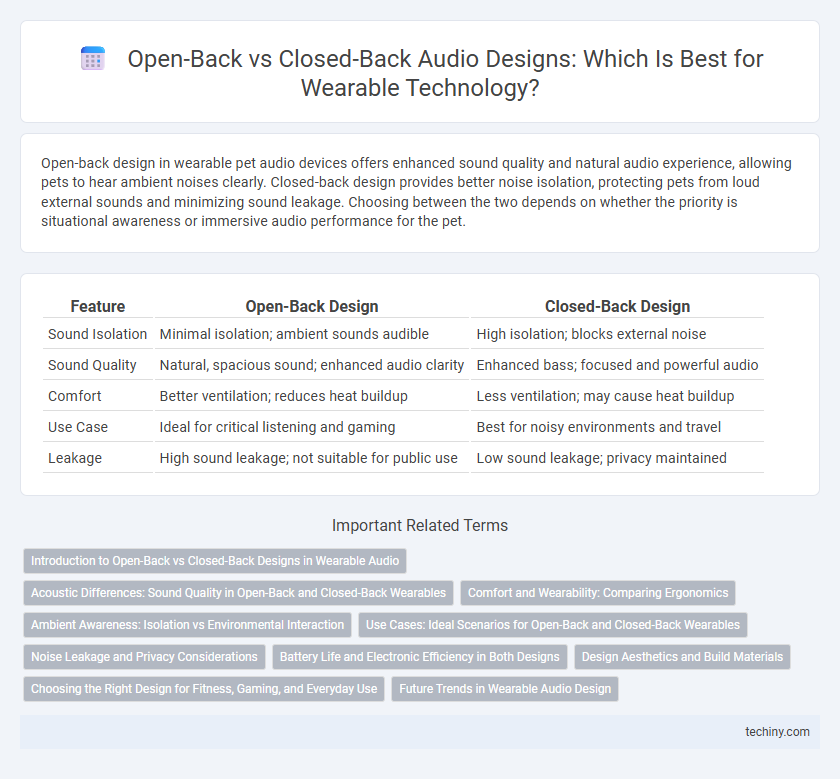Open-back design in wearable pet audio devices offers enhanced sound quality and natural audio experience, allowing pets to hear ambient noises clearly. Closed-back design provides better noise isolation, protecting pets from loud external sounds and minimizing sound leakage. Choosing between the two depends on whether the priority is situational awareness or immersive audio performance for the pet.
Table of Comparison
| Feature | Open-Back Design | Closed-Back Design |
|---|---|---|
| Sound Isolation | Minimal isolation; ambient sounds audible | High isolation; blocks external noise |
| Sound Quality | Natural, spacious sound; enhanced audio clarity | Enhanced bass; focused and powerful audio |
| Comfort | Better ventilation; reduces heat buildup | Less ventilation; may cause heat buildup |
| Use Case | Ideal for critical listening and gaming | Best for noisy environments and travel |
| Leakage | High sound leakage; not suitable for public use | Low sound leakage; privacy maintained |
Introduction to Open-Back vs Closed-Back Designs in Wearable Audio
Open-back designs in wearable audio devices feature earcups with perforations or grills that allow sound and air to pass through, creating a more natural and spacious listening experience with enhanced soundstage and reduced ear fatigue. Closed-back designs, by contrast, have sealed earcups that isolate sound, offering better noise isolation and bass response, making them ideal for noisy environments or privacy. Choosing between open-back and closed-back depends on the user's environment and audio preferences, balancing openness and immersion with isolation and focus.
Acoustic Differences: Sound Quality in Open-Back and Closed-Back Wearables
Open-back wearable audio devices deliver a more natural and spacious sound experience by allowing air and sound waves to pass freely, enhancing spatial awareness and reducing ear fatigue. Closed-back designs isolate the listener by sealing sound inside the earcup, providing superior noise isolation and deep bass response but potentially sacrificing soundstage breadth and natural acoustic clarity. Choosing between these designs depends on the desired balance of immersive sound quality and environmental awareness in wearable technology.
Comfort and Wearability: Comparing Ergonomics
Open-back design in wearable audio devices enhances comfort by allowing natural airflow, reducing heat buildup, and minimizing ear fatigue during extended use. Closed-back designs offer better noise isolation but can create pressure and warmth, potentially leading to discomfort over long periods. Ergonomically, open-back models prioritize breathability and lightweight materials, making them ideal for users seeking comfort in all-day wear.
Ambient Awareness: Isolation vs Environmental Interaction
Open-back design in wearable audio devices enhances ambient awareness by allowing external sounds to blend with audio playback, promoting environmental interaction and situational awareness. Closed-back design prioritizes sound isolation, blocking external noise for immersive listening experiences but reducing user connection to surrounding sounds. Choosing between these designs depends on the need for ambient interaction versus noise isolation in various use cases such as outdoor activities or focused environments.
Use Cases: Ideal Scenarios for Open-Back and Closed-Back Wearables
Open-back wearables excel in environments requiring natural sound awareness and enhanced audio quality, such as outdoor activities, gaming, or at-home listening, where environmental awareness and soundstage clarity are crucial. Closed-back wearables are ideal for noisy environments, commuting, or professional settings demanding minimal sound leakage and effective noise isolation to ensure audio privacy and concentration. Choosing between open-back and closed-back designs depends on balancing situational awareness with noise isolation according to the user's specific use case.
Noise Leakage and Privacy Considerations
Open-back design in wearable audio devices allows sound to escape freely, resulting in higher noise leakage but offering a more natural and spacious audio experience. Closed-back design provides better noise isolation by preventing sound from leaking out, enhancing privacy and reducing external noise interference. Users prioritizing privacy and minimal noise leakage should opt for closed-back wearables, while those seeking immersive sound quality may prefer open-back models.
Battery Life and Electronic Efficiency in Both Designs
Open-back wearable audio devices typically consume more power due to their design allowing sound to pass freely, requiring advanced drivers to maintain audio quality, which can reduce battery life. Closed-back designs offer better electronic efficiency by isolating sound within the earcups, enabling lower driver power consumption and extending battery performance. Battery optimization in closed-back wearables often results in longer usage times, making them preferable for users prioritizing device longevity.
Design Aesthetics and Build Materials
Open-back design in wearable audio devices emphasizes lightweight materials and visually striking mesh or grille patterns, enhancing breathability and modern aesthetics. Closed-back designs utilize denser, solid materials like metal or high-grade plastic, prioritizing a sleek, robust appearance and improved noise isolation. The choice of build materials directly influences the device's durability and style, with open-back designs favoring airy textures and closed-back designs showcasing polished, compact finishes.
Choosing the Right Design for Fitness, Gaming, and Everyday Use
Open-back designs in wearable audio devices offer superior soundstage and natural audio, making them ideal for gaming where spatial awareness enhances the experience. Closed-back designs provide better noise isolation and bass response, which benefits fitness activities by blocking external noise and improving focus. For everyday use, closed-back wearables are preferred for their versatility and sound isolation, while open-back options suit quiet environments and users prioritizing sound clarity over noise blocking.
Future Trends in Wearable Audio Design
Open-back design in wearable audio devices offers enhanced spatial awareness and natural sound quality, making it ideal for future applications that prioritize immersive experiences and situational awareness. Closed-back design provides superior noise isolation and bass response, critical for evolving use cases in noisy urban environments and fitness wearables. Emerging trends emphasize hybrid designs that merge open-back transparency with closed-back isolation, driven by advancements in materials and adaptive noise control technologies.
Open-Back Design vs Closed-Back Design (for wearables audio devices) Infographic

 techiny.com
techiny.com